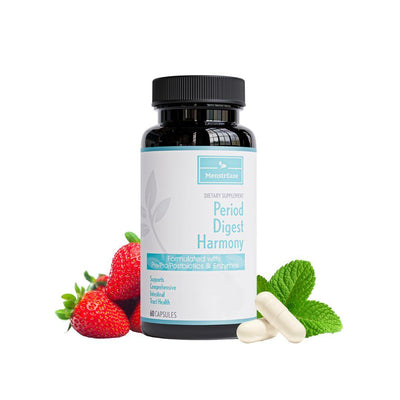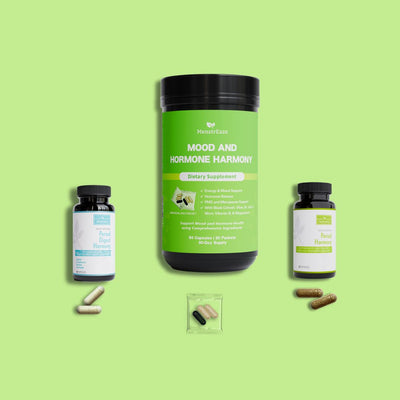In the bustling world of health and wellness, new terms and trends emerge regularly. One such area gaining significant attention is the realm of gut health, and specifically, the role of prebiotics. There is an increasing interest in functional foods and bioactive compounds like prebiotics that can aid in the prevention and treatment of chronic diseases [1]. But what exactly are prebiotics, and more importantly, why should women, in particular, pay attention to them? The connection between the gut and a woman's overall vitality is profound and often underestimated. Beyond simple digestion, the gut influences hormonal balance, immune strength, mental clarity, and much more – all areas of critical importance throughout a woman's unique life journey.
Many women are seeking natural ways to support their digestion, achieve better hormonal equilibrium, or bolster their immune defenses. The answer to these quests may lie within the intricate ecosystem of the gut, with prebiotics serving as a key to unlocking its potential. This guide will delve into the science behind prebiotics, explore their specific and multifaceted benefits for women at every stage of life, offer practical advice on incorporating them into daily diets, and provide insights into navigating the world of prebiotic supplements wisely.
Decoding Prebiotics: Your Gut's Best Friends
Understanding what prebiotics are and how they function is the first step in appreciating their value for women's health.
Clear Definition of Prebiotics
The scientific understanding of prebiotics has evolved. The current consensus definition, established by The International Scientific Association for Probiotics and Prebiotics (ISAPP), states that "prebiotics are substrates that are selectively utilized by host microorganisms conferring a health benefit" [2]. This definition refines an earlier one from 1995 which described prebiotics as "a nondigestible food ingredient that beneficially affects the host by selectively stimulating the growth and/or activity of one or a limited number of bacteria in the colon, and thus improves host health" [2]. The key elements in the modern understanding are the selective utilization by the host's existing microbes and the resultant health benefit.
In simpler terms, prebiotics act as specialized food or "fertilizer" for the beneficial bacteria already residing in the gut [4]. They are typically non-digestible food components, primarily dietary fibers, that are able to resist digestion in the stomach and small intestine. This resistance allows them to reach the colon largely intact, where they can nourish and support the growth of friendly microorganisms [2].
How They Differ from Probiotics (and Their Synergistic Relationship)
It is common to confuse prebiotics with probiotics, but they play distinct, albeit complementary, roles in gut health. Probiotics are live beneficial microorganisms—actual bacteria or yeasts—that, when consumed in adequate amounts, confer a health benefit [4]. Think of probiotics as the "seeds" sown to populate the garden of the gut.
Prebiotics, on the other hand, are the non-living substances that feed these beneficial microbes, acting like "fertilizer" to help them thrive and multiply [5]. This distinction is crucial: probiotics introduce new beneficial microbes, while prebiotics nourish and encourage the growth of the good microbes already present.
The relationship between prebiotics and probiotics can be synergistic. When combined, often in products known as "synbiotics," they can work together more effectively. The prebiotic component in a synbiotic formulation is thought to improve the viability and activity of the probiotic component, enhancing its chances of survival and colonization in the gut [4]. This highlights how these two components can work hand-in-hand to support a healthy gut environment.
Mechanism of Action: How Prebiotics Work Their Magic
The "magic" of prebiotics lies in their specific interactions within the colon and the beneficial byproducts that result.
Selective Fermentation: A defining characteristic of prebiotics is their ability to selectively stimulate the growth and/or activity of certain beneficial bacteria, most notably species like Bifidobacteria and Lactobacilli, within the colon [2]. This selectivity is important; not all dietary fibers are prebiotics because not all fibers specifically target these health-promoting bacteria. This targeted nourishment helps to shift the balance of the gut microbiota in a favorable direction.
Production of Short-Chain Fatty Acids (SCFAs): One of the most significant outcomes of prebiotic fermentation by beneficial gut bacteria is the production of short-chain fatty acids (SCFAs), primarily acetate, propionate, and butyrate [3]. These SCFAs are powerhouses of health benefits:
- Butyrate: This SCFA is particularly noteworthy as it serves as the preferred energy source for colonocytes (the cells lining the colon). A steady supply of butyrate helps maintain the health and integrity of the gut lining and may offer protection against certain colonic disorders [3].
- Acetate & Propionate: These SCFAs are absorbed into the bloodstream and can exert systemic effects. Acetate is metabolized by various tissues, including the brain and muscles, while propionate is primarily cleared by the liver and may play a role in lowering the hepatic production of cholesterol [3].
- Lowered Colonic pH: The production of SCFAs contributes to a more acidic environment (lower pH) in the colon. This lower pH is less hospitable to many pathogenic (harmful) bacteria and creates more favorable conditions for the growth of beneficial microbes like Bifidobacteria and Lactobacilli [3].
Enhanced Gut Barrier Function: A healthy gut barrier is crucial for preventing unwanted substances from "leaking" from the intestines into the bloodstream, a phenomenon often referred to as "leaky gut," which can trigger inflammation and other health issues. Prebiotics, often through the action of SCFAs and the proliferation of beneficial bacteria they support, contribute significantly to strengthening this barrier. They can help restore intestinal permeability, stimulate the production of protective mucus, promote mucosal regeneration, and maintain the overall integrity of the mucosal barrier [6]. This fortification of the gut's defenses is vital for overall health.
The capacity of prebiotics to act as precision fuel is a cornerstone of their effectiveness. Unlike general fiber which provides bulk, prebiotics are specifically chosen by beneficial bacteria. This selective nourishment of strains like Bifidobacterium and Lactobacillus leads to a more targeted and potent impact on the gut ecosystem [2]. Furthermore, the SCFAs produced are not confined to the gut; their absorption into the bloodstream allows them to act as signaling molecules with systemic effects on immunity, metabolism, and potentially even brain function, illustrating how prebiotics can influence health far beyond the digestive tract [3].
Prebiotics & Women's Health: A Powerful Connection
The general benefits of prebiotics for gut health lay the foundation for their specific advantages in addressing various aspects of women's health.
Digestive Harmony
A well-functioning digestive system is central to overall well-being, and prebiotics play a key role in achieving this.
General Gut Health:
By nourishing the beneficial microbes already present in the gut, prebiotics help maintain a balanced microbiome [4]. This balance is fundamental for robust gastrointestinal health, contributing to a healthy immune system and supporting weight management efforts [3].
Alleviating Common Issues:
- Constipation: Certain prebiotic fibers, such as inulin, can be effective in relieving constipation. They work by increasing stool frequency and contributing to stool bulk, partly due to the increased bacterial mass resulting from their fermentation [3].
- Bloating & Irritable Bowel Syndrome (IBS): The role of prebiotics in IBS is more complex. While they have been shown to increase levels of beneficial Bifidobacteria in individuals with IBS [9], their impact on global IBS symptoms like abdominal pain and bloating is not consistently positive across all studies or prebiotic types [10]. Some prebiotics, particularly inulin-type fructans and especially at higher doses, may initially worsen flatulence or bloating in sensitive individuals due to increased gas production from fermentation [3]. Conversely, other types, such as non-inulin-type fructans or lower doses of prebiotics, might improve flatulence [10]. It is often suggested that probiotics may offer more direct relief for overall IBS symptoms compared to prebiotics alone [11]. For women prone to bloating, it is advisable to introduce prebiotics slowly, starting with small amounts to assess tolerance [9].
- Traveler's Diarrhea: Some evidence suggests that inulin may help reduce the incidence and severity of traveler's diarrhea, offering a potential protective measure during travel [3].
The mechanisms underpinning these digestive benefits include the favorable modulation of the gut microbiota, the production of beneficial SCFAs, and the improvement of gut barrier function [3]. For women experiencing IBS, it's important to recognize this nuance: while prebiotics contribute to a healthier gut environment which could indirectly benefit IBS, they may not be a primary solution for immediate symptom relief for everyone, and careful selection and dosing are key.
Vaginal & Urogenital Wellness
The health of the gut microbiome has surprising and significant implications for a woman's vaginal and urogenital health, a connection often referred to as the "gut-vagina axis."
The Gut-Vagina Axis: This concept highlights the communication and microbial exchange between the gut and the vaginal environment. The gut can serve as a reservoir for both beneficial bacteria, like Lactobacilli, and potential pathogens that can migrate to and influence the vaginal microbiome [12]. Furthermore, poor gut health can contribute to systemic inflammation, which may also affect the vagina. The gut microbiome can even influence levels of hormones, such as estrogen, which are crucial for maintaining a healthy vaginal environment [12].
Supporting a Healthy Vaginal Microbiome: A healthy vaginal microbiome in reproductive-aged women is typically characterized by a dominance of Lactobacillus species. These beneficial bacteria produce lactic acid, which helps maintain an acidic vaginal pH (around 3.5-4.5). This acidity creates an environment that inhibits the growth of pathogenic microorganisms and helps protect against infections [13]. While direct evidence proving that oral prebiotics substantially alter the vaginal microbiota is still an area of active research (one study on oral probiotics found no detectable effect on vaginal microbiota composition [16]), the indirect pathway via the gut-vagina axis is considered plausible. If oral prebiotics enhance the populations of Lactobacilli in the gut, this could theoretically support or contribute to healthier Lactobacilli levels in the vagina [12]. Immune cells producing IgA (an antibody important for mucosal immunity) in the vagina may originate from the intestine, suggesting another link in this axis [17].
Potential Role in Preventing BV and UTIs:
- Bacterial Vaginosis (BV): BV is a common vaginal condition marked by a depletion of beneficial Lactobacilli and an overgrowth of other, often anaerobic, bacteria [18]. This imbalance can lead to symptoms like odor and discharge and increase susceptibility to other infections. Probiotics, often formulated with prebiotics in synbiotic products, are being explored as a strategy to help restore a Lactobacillus-dominant vaginal flora and prevent recurrent BV [13]. The rationale is that prebiotics would provide nourishment for the beneficial Lactobacilli, helping them to thrive and outcompete pathogens.
- Recurrent Urinary Tract Infections (rUTIs): The gut is a major reservoir for uropathogens, with Escherichia coli (E. coli) being a common culprit in UTIs [20]. While specific evidence for prebiotics alone in rUTI prevention is limited, probiotics, particularly Lactobacillus strains, are considered a potential preventive measure [14]. By fostering a healthier gut microbiome, prebiotics might help reduce the intestinal load of potential uropathogens, thereby indirectly lowering the risk of UTIs. Some commercial probiotic products aimed at vaginal health incorporate prebiotics alongside probiotic strains [22].
Hormonal Balance Through the Ages
The gut microbiome plays an unexpectedly significant role in regulating hormones, particularly estrogen, which is pivotal for many aspects of women's health.
The Estrobolome: Within the gut, there exists a collection of bacterial genes collectively termed the "estrobolome." These genes enable certain gut bacteria to metabolize and modulate estrogens [12]. Essentially, these bacteria can influence how estrogen is processed in the body, affecting the levels of circulating estrogen. A healthy, diverse gut microbiome, which can be supported by prebiotics, is thought to contribute to maintaining optimal estrogen levels, which is crucial for everything from reproductive health to bone density and mood [12].
Support for PCOS Symptoms: Polycystic Ovary Syndrome (PCOS) is a common endocrine disorder in women, often characterized by hormonal imbalances (such as elevated androgens), menstrual irregularities, and metabolic issues like insulin resistance.
- Emerging research suggests that prebiotics, either alone or as part of synbiotic formulations, may offer benefits for women with PCOS. A systematic review and meta-analysis indicated that such interventions could positively affect several cardiometabolic parameters, including reductions in body mass index (BMI) and diastolic blood pressure. Subgroup analyses hinted at possible reductions in LDL cholesterol with prebiotics, and potential decreases in waist circumference, total cholesterol, and total testosterone with synbiotics [6].
- Interventions with probiotics (which prebiotics are designed to feed and support) have also demonstrated promise. Studies have shown that probiotic supplementation can lead to improvements in the hormonal profiles of women with PCOS, including decreases in luteinizing hormone (LH), thyroid-stimulating hormone (TSH), and androstenedione levels, alongside an increase in sex hormone-binding globulin (SHBG), and a reduction in BMI [6].
Navigating Menopause: The menopausal transition brings a natural decline in estrogen levels, which can significantly impact the gut microbiota. These changes in the gut microbiome may, in turn, contribute to common menopause-related experiences such as weight gain, alterations in bone health, mood changes, and cognitive shifts [24].
- Therapeutic modulation of the gut microbiota through prebiotics and probiotics is being explored as a potential strategy to help manage these menopausal symptoms. Such interventions aim to increase bacterial diversity in the gut and improve metabolic health, potentially alleviating some of the challenges associated with menopause [24]. Indeed, probiotic use has been linked to a reduction in menopausal symptoms in some studies [6].
Strong Bones, Strong Women
Bone health is a critical concern for women throughout their lives, from building peak bone mass in youth to preventing osteoporosis in later years. Prebiotics can play a supportive role in this area, primarily by enhancing mineral absorption.
Enhancing Calcium Absorption: Several types of prebiotics, including fructooligosaccharides (FOS), galactooligosaccharides (GOS), inulin, and soluble corn fiber, have been demonstrated in both preclinical and human studies to increase the absorption of calcium in the lower intestines [1]. Calcium is the primary mineral component of bones, making its efficient absorption essential for skeletal health.
Mechanisms: The enhanced mineral absorption facilitated by prebiotics is thought to occur through several interconnected mechanisms:
- Alterations in Gut Microbiota: Prebiotics selectively promote the growth of beneficial bacteria.
- SCFA Production: The fermentation of prebiotics by these bacteria leads to the production of SCFAs. These SCFAs lower the pH in the colon, which can increase the solubility of minerals like calcium, making them more available for absorption. SCFAs might also directly influence the cells lining the colon to enhance mineral transport [1].
- Changes in Mineral Transport Proteins: There is some evidence suggesting prebiotics may influence the expression of proteins involved in transporting calcium across the intestinal wall [1].
Importance for Adolescents: Adolescence is a critical window for building bone density to achieve peak bone mass, which is a key determinant of fracture risk later in life. Studies involving adolescent girls have shown that prebiotics such as GOS, mixtures of inulin-type fructans, and soluble corn fiber can significantly enhance calcium absorption and support bone mineralization [1].
Importance for Postmenopausal Women: Postmenopausal women face an increased risk of osteoporosis and fractures due to the decline in estrogen, a hormone that plays a protective role in bone maintenance [29]. Prebiotics offer a potential nutritional strategy to help mitigate bone loss in this population. Research has indicated that prebiotics like oligofructose-enriched inulin, soluble corn fiber, and short-chain FOS can improve calcium absorption and retention, and in some cases, reduce markers of bone turnover (indicating less bone breakdown) in postmenopausal women [1]. Furthermore, probiotic supplementation has also been linked to increased bone mineral density (BMD) in postmenopausal women, particularly those with osteopenia [29].
The benefits of prebiotics for bone health underscore their relevance across a woman's lifespan, supporting foundational bone building in youth and helping to preserve bone strength during the aging process.
Boosting Your Immune Defenses
A robust immune system is vital for fending off infections and maintaining overall health. The gut plays a surprisingly central role in immune function, with a large proportion of the body's immune cells located within or around the gastrointestinal tract [5].
How Prebiotics Modulate Immunity: Prebiotics contribute to immune health through several mechanisms:
- Promoting Beneficial Bacteria: By selectively nourishing beneficial bacteria, prebiotics help these friendly microbes to flourish. A thriving population of good bacteria can outcompete pathogenic (harmful) microbes for space and nutrients, effectively reducing the chances of infection [3].
- SCFA Production and Anti-inflammatory Effects: The SCFAs produced from prebiotic fermentation, such as butyrate, acetate, and propionate, have immunomodulatory properties. They can help counteract inflammatory states in the body and support the healthy functioning of immune cells [2].
- Strengthening the Gut Barrier: As previously discussed, prebiotics enhance the integrity of the intestinal barrier [6]. A strong gut barrier prevents undigested food particles, toxins, and pathogens from leaking into the bloodstream, which could otherwise trigger an inappropriate immune response and systemic inflammation.
- General Immunomodulation: Prebiotics can exert a general immunomodulatory effect on the host. This may involve reducing pro-inflammatory responses, which can be particularly beneficial in older adults who may experience age-related immune decline (immunosenescence), and improving innate immune dysfunction [2].
- Supporting Key Immune-Related Bacteria: Many prebiotics, including GOS, FOS, and chicory inulin, have been shown to support the growth of Bifidobacterium and Lactobacillus species. These bacteria are crucial for maintaining intestinal health and play a significant role in balancing the immune system [2].
Mind & Mood: The Gut-Brain Connection
The idea that the gut and brain are interconnected is not new, but the depth and complexity of this relationship, known as the "gut-brain axis," are becoming increasingly clear. The gut microbiome is a key player in this bidirectional communication system, influencing mood, stress responses, and even cognitive functions [2].
Introducing the Gut-Brain Axis: This intricate network involves neural, hormonal, and immunological pathways that allow the gut and brain to constantly "talk" to each other. The trillions of microbes residing in the gut can produce a vast array of neuroactive compounds that can influence brain chemistry and function.
Impact on Stress, Anxiety, and Cognition: Emerging research suggests that prebiotics may positively influence mental well-being:
- Stress Reduction: Some studies indicate that prebiotic consumption may help reduce perceived stress. This effect is thought to be linked to the modulation of specific gut bacteria, such as Bifidobacterium, or other microbial taxa by prebiotics [2].
- Cognitive Function: There is evidence suggesting that certain prebiotics, like inulin and polydextrose, can have a positive impact on cognitive functions, including attention and mental flexibility. These improvements may be mediated by changes in the gut microbiota (e.g., modulation of Ruminococcus species) and a subsequent reduction in inflammatory markers that can affect brain health [2].
- Anxiety and Depression: While the role of prebiotics in anxiety and depression is still an area of active investigation and considered somewhat controversial, preliminary data suggest potential correlations [2]. For example, one study reported improvements in self-efficacy scores in patients with depressive episodes after consuming galactosylsucrose [2].
The mechanisms by which prebiotics influence the brain are thought to involve the production of various metabolites by gut bacteria (whose composition and activity are shaped by prebiotics). These metabolites can directly or indirectly affect brain function, energy levels, and cognition [2]. Additionally, by reducing systemic inflammation, which is increasingly linked to mood disorders, prebiotics may also contribute to better mental health.
The diverse benefits of prebiotics for women highlight a fundamental principle: the health of the gut microbiome is not an isolated concern but rather a central pillar supporting numerous physiological systems. Improvements in digestive health through prebiotics can lead to better nutrient absorption, which is crucial for bone health. A balanced gut microbiome can reduce systemic inflammation, benefiting immune function, hormonal equilibrium, and mental well-being. Furthermore, the gut-vagina axis illustrates a direct link between intestinal health and urogenital wellness. This interconnectedness means that nourishing the gut with prebiotics can create a positive ripple effect across many aspects of a woman's health.
Nourishing Your Gut: Prebiotic-Rich Foods for Every Woman
While supplements have their place, a "food first" approach is often the best strategy for incorporating prebiotics into a healthy lifestyle. Nature offers a diverse and delicious array of foods rich in these beneficial fibers.
A wide variety of common foods across different food groups contain valuable prebiotics:
- Vegetables: Onions, garlic, and leeks are excellent sources of inulin and fructooligosaccharides (FOS) [31]. Asparagus provides FOS [31], while Jerusalem artichokes (also known as sunchokes) and chicory root are particularly rich in inulin [31]. Dandelion greens also contain inulin [33], and globe artichokes are another good source [34].
- Fruits: Bananas, especially when slightly greenish, offer resistant starch and FOS [4]. Apples are a good source of pectin, a type of prebiotic fiber [31]. Berries, such as blueberries and raspberries, contain polyphenols which can exert prebiotic-like effects by promoting beneficial bacteria [31]. Citrus fruits like oranges and grapefruit also provide pectin [31].
- Grains: Oats and barley are well-known for their beta-glucan content, a soluble fiber with prebiotic properties [4]. Whole wheat can be a source of resistant starch [31], and rye is another beneficial grain [33].
- Legumes: Chickpeas, lentils, and various types of beans (kidney, black, pinto) are packed with galactooligosaccharides (GOS) and resistant starch [31].
- Nuts & Seeds: Flaxseeds are a good source of prebiotic fiber [4]. Almonds, cashews, and pistachios also contribute to prebiotic intake [33].
- Other Sources: Certain types of honey, such as manuka, clover, and acacia, contain prebiotic oligosaccharides [32].
Incorporating these foods into daily meals can be simple. For example, adding onions and garlic to most savory dishes is an easy win. Snacking on an apple with the skin, enjoying overnight oats for breakfast, including beans or lentils in salads and soups, and choosing whole grain breads and cereals are all effective strategies. A particularly useful tip for increasing resistant starch content in foods like potatoes and rice is to cook them and then allow them to cool before eating, as this process increases the formation of resistant starch [31].
It's important to aim for diversity in prebiotic food sources. Different types of prebiotic fibers—such as inulin, FOS, GOS, beta-glucan, pectin, and resistant starch—are known to feed different types of beneficial bacteria [5]. Since a diverse gut microbiome is generally considered healthier [12], consuming a wide variety of these foods ensures a broader spectrum of nourishment for the gut ecosystem, likely leading to more comprehensive health benefits than relying on just one or two sources. The way foods are prepared can also influence their prebiotic content. For instance, the "cook and cool" method significantly boosts resistant starch in starchy foods [31], offering a practical way for women to maximize their prebiotic intake from everyday staples.
To further illustrate how these foods can support women's health, the following table provides some examples:
Table: Prebiotic-Rich Foods for Women's Health
|
Food Item |
Key Prebiotic Type(s) |
Serving Suggestion |
Specific Relevance for Women's Health |
|
Onions & Garlic |
Inulin, FOS |
Add to soups, stews, stir-fries, sauces |
Foundational for gut health, may support immune function [32] |
|
Asparagus |
FOS, Inulin |
Steamed, roasted, added to salads or frittatas |
Provides folate (important for reproductive health), good source of Vitamin K (bone health) [31] |
|
Bananas (greenish) |
Resistant Starch, FOS |
In smoothies, sliced on cereal, as a snack |
Good source of potassium (heart health, blood pressure regulation), sustained energy release [4] |
|
Apples (with skin) |
Pectin |
Whole as a snack, sliced in salads or oatmeal |
Soluble fiber helps with satiety and blood sugar control, good for heart health [31] |
|
Oats |
Beta-glucan |
Oatmeal, in smoothies, homemade granola |
Supports heart health (cholesterol-lowering), helps stabilize blood sugar, promotes satiety [4] |
|
Lentils & Beans |
GOS, Resistant Starch |
In soups, stews, salads, as a side dish |
Excellent source of plant-based protein and iron (crucial for energy and preventing anemia, common in women), high in fiber [31] |
|
Chicory Root |
Inulin |
Often found in prebiotic supplements or fiber bars |
Potent prebiotic effect, supports calcium absorption [31] |
|
Flaxseeds (ground) |
Lignans, Soluble Fiber |
Add to smoothies, yogurt, oatmeal, baked goods |
Source of omega-3 fatty acids (anti-inflammatory), lignans may have hormone-balancing properties [4] |
|
Jerusalem Artichoke |
Inulin |
Roasted, pureed into soups |
High in inulin, supports beneficial gut bacteria, source of iron and potassium [32] |
Considering Prebiotic Supplements: A Woman's Guide
While a diet rich in diverse, whole foods is the ideal way to obtain prebiotics, supplements can play a supportive role in certain situations.
When Might Supplements Be Beneficial?
Prebiotic supplements may be considered under several circumstances:
- Dietary Insufficiency: If dietary intake of prebiotic-rich foods is consistently low or if it's challenging to consume enough fiber to meet daily recommendations. National data indicates that more than 90% of women do not meet the recommended daily intakes for dietary fiber, which is typically 21-25 grams per day for women [36]. Supplements can help bridge this common nutritional gap.
- Convenience: For individuals with busy lifestyles, during travel, or when access to a wide variety of fresh, prebiotic-rich foods is limited, supplements can offer a convenient way to ensure adequate intake.
- Targeted Dosing for Specific Conditions: In some cases, specific types or higher doses of prebiotics might be explored for particular health concerns, based on scientific research. However, this approach should ideally be guided by a knowledgeable healthcare professional.
Common Types of Prebiotic Supplements
Several types of prebiotic fibers are commonly found in supplements. These include:
- Inulin: A type of fructan, widely studied and commonly used.
- Fructo-oligosaccharides (FOS): Shorter chains of fructose molecules.
- Galacto-oligosaccharides (GOS): Composed of galactose sugars.
- Xylo-oligosaccharides (XOS): Derived from plant fibers like corn cobs or wood.
- Psyllium: While primarily known as a bulk-forming laxative, psyllium husk also has prebiotic effects as it can be fermented by gut bacteria.
- Wheat Dextrin: A soluble fiber produced from wheat starch.
- Polydextrose: A synthetic polymer of glucose.
- Acacia Gum (Gum Arabic): A natural gum derived from the acacia tree, which is a soluble fiber with prebiotic properties [1].
Forms Available
Prebiotic supplements are available in various forms to suit different preferences:
- Powders: These can be easily mixed into beverages (water, juice, smoothies) or soft foods (yogurt, oatmeal). Powders often offer greater flexibility in adjusting dosage [36].
- Capsules: Convenient for those who prefer not to taste the supplement or want a pre-measured dose.
- Gummies: A popular option due to their palatability. However, it's important to check the sugar content, as some gummies may contain added sugars [36].
General Dosage Recommendations and Starting Slow
Dosage for prebiotic supplements can vary significantly depending on the specific type of prebiotic fiber and the product formulation.
- For inulin, doses ranging from 8-18 grams daily have been used safely in studies for up to 24 weeks, with common supplement doses often falling between 10-40 grams per day for periods of 4-8 weeks [8].
- For GOS, adult doses have typically ranged from 5-20 grams per day for up to 30 days [39].
- Commercial products will provide their own serving suggestions, for example, some prebiotic gummies suggest 3 gummies providing 6 grams of fiber [36].
Regardless of the type or form, a crucial piece of advice is to start with a low dose and increase gradually over several days or weeks [8]. This allows the digestive system to adapt and helps to minimize potential side effects such as gas, bloating, or abdominal discomfort, which can occur if a large amount of prebiotic fiber is introduced suddenly. Always refer to the product label for specific dosage instructions and consult with a healthcare provider if unsure.
The supplement industry operates with minimal external oversight, and many product claims lack robust scientific backing [40]. This reality places a significant responsibility on the consumer to be discerning. Prioritizing products that have undergone third-party testing for purity and potency is not just advisable but essential for safety and efficacy. Furthermore, the common advice to "start low and go slow" with prebiotic dosage is critical because individual tolerance varies greatly [8]. A higher dose is not necessarily better if it leads to significant discomfort, which can hinder consistent use.
To help navigate these choices, consider the following factors:
Table: Choosing a Prebiotic Supplement: Key Considerations for Women
|
Factor |
Why It Matters for Women |
What to Look For/Questions to Ask |
|
Type of Prebiotic |
Different types (Inulin, FOS, GOS, XOS, blends) may have varying tolerability and some research might favor specific types for certain health benefits (e.g., inulin/FOS for calcium absorption [1]). |
What type(s) of prebiotic does it contain? Is there research supporting this type for my specific health goals? |
|
Dosage/Fiber Content per Serving |
Needs to align with general recommendations or specific needs to be effective. |
How many grams of prebiotic fiber are in each serving? Is this a meaningful dose based on available research? [8] |
|
Purity & Quality (Third-Party Testing) |
Ensures the product is safe, contains what the label states, and is free from contaminants. Crucial due to limited regulation [40]. |
Is the product third-party tested by a reputable organization (e.g., USP, NSF, ConsumerLab)? Does the brand provide transparency about its quality control? [40] |
|
Specific Women's Health Needs |
Allows for a more targeted approach if a supplement is formulated or has evidence supporting its use for a particular concern (e.g., digestive regularity, bone health). |
Does this supplement align with my primary health concerns? Are claims backed by evidence relevant to women? |
|
Potential Side Effects/Tolerability |
Some prebiotics (e.g., high-dose inulin) are more prone to causing gas/bloating [3]. Individual sensitivity varies. |
Am I prone to digestive upset? Should I choose a type known for better tolerability or start with an extremely low dose? |
|
Other Ingredients |
Important to check for allergens (e.g., gluten, dairy, soy), added sugars (especially in gummies [38]), artificial sweeteners, or unnecessary fillers. |
Does the product contain any ingredients I need to avoid? Is the sugar content acceptable? |
|
Form (Powder, Capsule, Gummy) |
Affects ease of use and personal preference. |
Which form will I be most consistent with taking? Do gummies have excessive added sugar? Do powders mix well? |
Important Considerations for Women
While prebiotics offer many potential benefits, there are important considerations to keep in mind for their safe and effective use.
Potential Side Effects and Management
The most commonly reported side effects associated with prebiotic intake are gastrointestinal in nature. These can include:
- Gas (flatulence)
- Bloating
- Abdominal discomfort or cramping
- Changes in stool consistency, which might manifest as diarrhea or, for some, initial constipation [3].
These effects are generally a result of the fermentation process in the colon as the gut bacteria metabolize the prebiotic fibers. For many individuals, these symptoms are mild and tend to subside as the digestive system adjusts to the increased fiber intake over a few days to a couple of weeks.
To manage and minimize these potential side effects:
- Start with small doses: Introduce prebiotics, whether from food or supplements, gradually. For supplements, this might mean starting with a quarter or half of the recommended dose and slowly increasing it over several days or weeks [8].
- Increase fluid intake: Drinking plenty of water can help with the transit of fiber through the digestive system and may alleviate some discomfort.
- Choose wisely: Some prebiotic fibers, such as wheat dextrin and polydextrose, are often reported to be better tolerated and less likely to cause significant symptoms compared to others, like inulin, especially when the latter is consumed in large amounts [35].
The principle of "listening to your body" is paramount. Individual tolerance to different types and amounts of prebiotics can vary significantly due to unique gut microbiomes and sensitivities. What works well for one woman might cause discomfort for another. It's important to adjust intake based on personal response rather than pushing through significant or persistent side effects.
Safety During Pregnancy and Lactation
The safety of prebiotics during pregnancy and lactation is a common concern. Current evidence is largely reassuring:
- Systematic reviews and meta-analyses have generally concluded that probiotic and prebiotic products are safe for use by pregnant and lactating women. These reviews suggest that adverse effects associated with their use typically do not pose serious health concerns to either the mother or the infant [42].
- One study included in a systematic review did report an increased risk of vaginal discharge and changes in stool consistency in women taking specific Lactobacillus strains (which are probiotics, though often found in synbiotic products with prebiotics) [42].
- Regarding specific prebiotics, galactooligosaccharides (GOS) are considered possibly safe when taken in doses of around 4.5 grams daily during pregnancy [39]. Inulin is likely safe when consumed in amounts typically found in foods. However, there is less reliable information on the safety of larger, medicinal amounts of inulin supplements during pregnancy or breastfeeding, so it is advisable to be cautious with high-dose supplementation [8].
Despite the generally favorable safety profile, it is crucial for any woman who is pregnant, planning to become pregnant, or breastfeeding to consult with her healthcare provider (such as a doctor, obstetrician, or registered dietitian) before starting any new supplement, including prebiotics.
Prebiotics and SIBO (Small Intestinal Bacterial Overgrowth)
Small Intestinal Bacterial Overgrowth (SIBO) is a condition characterized by an excessive number of bacteria in the small intestine, an area of the gut where bacterial populations should normally be relatively low [44].
The dietary management of SIBO often involves a diet low in FODMAPs (Fermentable Oligosaccharides, Disaccharides, Monosaccharides, and Polyols). Many prebiotic fibers fall under the FODMAP umbrella because they are readily fermented by bacteria [44]. In individuals with SIBO, introducing highly fermentable prebiotics could potentially worsen symptoms like bloating, gas, and pain. This is because the prebiotics would provide additional fuel for the bacteria already overgrowing in the small intestine, leading to increased fermentation and gas production in an inappropriate location.
Therefore, women who have been diagnosed with SIBO or suspect they might have it should exercise caution and consult their healthcare provider before using prebiotic supplements or significantly increasing their intake of prebiotic-rich foods. The treatment for SIBO typically involves addressing the underlying cause, often using specific antibiotics to reduce the bacterial overgrowth, followed by careful dietary strategies to prevent recurrence [44]. Prebiotics might be cautiously reintroduced later, under guidance, once the SIBO has been effectively managed. This highlights that the baseline state of an individual's gut health is a critical factor; what is beneficial for a generally healthy gut may not be appropriate in certain pathological conditions like SIBO.
Potential Drug Interactions
Prebiotics, like many dietary supplements, have the potential to interact with certain medications. It's important to be aware of these possibilities:
- Antibiotics: If a product contains live bacteria (i.e., probiotics, which are sometimes combined with prebiotics in synbiotic formulas), taking them concurrently with antibiotics can reduce the efficacy of the probiotic component, as antibiotics can kill these beneficial bacteria. It is generally recommended to take such products at least 2 to 3 hours before or after an antibiotic dose [46].
- Diabetes Medications: Some prebiotics, notably inulin, might have a mild blood sugar-lowering effect. If taken alongside antidiabetes medications (e.g., insulin, metformin), there is a potential risk of blood sugar dropping too low (hypoglycemia). Individuals with diabetes should monitor their blood sugar levels closely if they start taking inulin supplements and discuss this with their doctor [8]. Berberine, an herbal compound sometimes included in supplements (though not a prebiotic itself), also shares this effect and has numerous other documented drug interactions, particularly with medications metabolized by the liver's cytochrome P450 enzyme system and anticoagulants [47].
- General Caution: The list of potential interactions is not exhaustive, and effects can vary. It is always best practice for women to discuss all supplement use, including prebiotics, with their doctor or a pharmacist, especially if they are taking any prescription or over-the-counter medications. This allows for a review of potential interactions and ensures safe use [40].
Conclusion: Empower Your Health with Prebiotics
Prebiotics stand out as powerful, natural allies in a woman's pursuit of health and vitality. Working subtly from the inside out, these unique dietary fibers nourish the trillions of beneficial bacteria that make up the gut microbiome, an internal ecosystem increasingly recognized as a cornerstone of overall well-being.
The benefits for women are multifaceted and significant, extending far beyond mere digestive comfort. From fostering a balanced vaginal and urogenital environment and supporting hormonal harmony through critical life stages like PCOS and menopause, to strengthening bones, bolstering immune defenses, and even positively influencing mind and mood via the gut-brain axis, the impact of a well-nourished microbiome is profound.
The journey towards harnessing the power of prebiotics should ideally begin with a "food first" philosophy. Nature provides an abundant and delicious array of prebiotic-rich foods—colorful fruits and vegetables, hearty whole grains, and versatile legumes—that can be easily incorporated into daily meals. Embracing dietary diversity is key to cultivating a resilient and thriving gut ecosystem.
While whole foods are paramount, prebiotic supplements can play a valuable supportive role, particularly when dietary intake is challenging or when specific therapeutic goals are being pursued. However, navigating the supplement landscape requires discernment. Choosing high-quality, third-party tested products, starting with low doses to assess individual tolerance, and, most importantly, consulting with a healthcare professional are crucial steps to ensure both safety and efficacy.
Ultimately, understanding and nurturing the gut microbiome through thoughtful prebiotic intake is an investment in long-term health. By making informed choices about what feeds this vital inner ecosystem, women can take proactive steps towards enhanced well-being, empowering themselves to live healthier, more vibrant lives. The path to a more balanced and resilient you can indeed start with these simple, yet impactful, dietary decisions.






